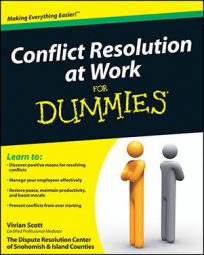Professional mediators understand the dynamics and subtleties involved when dealing with conflict in the workplace. Taking the right approach to conflict resolution goes a long way. Here are some pointers and techniques professionals use while helping to resolve employee conflict:
Value the process as much as the outcome: Striving to improve a working relationship gives you more than a momentary solution. A mediation process that allows the parties to come away with an understanding of the real issues can also deliver broader benefits, such as more collaboration between the two parties, an increase in creativity, and a boost in productivity.
Accept that her truth is her reality: Acting as the judge, jury, and executioner isn’t the point of mediating conflict. The purpose of the discussions isn’t for you to find out who’s telling the truth and who’s lying — for the people involved, the stories they share are the truth. Work within a person’s point of view to help her find resolution.
Rapport matters: Presenting yourself professionally and being open to input from all sides creates a comfortable environment for both parties to be honest with you about what’s happening and what they’re willing to do to resolve the difficulty.
Get off to a good start by being genuinely interested in the perspectives from all the people involved in the conflict.
Be present and available: Give your full attention to the individuals sitting in front of you during a conversation about conflict — not the computer, not your phone, not the knock on the door. Put the golden rule into play and give others the same care and attention you’d want in the same situation.
Find common ground for more success: People in conflict have a tendency to focus only on differences, and these differences are what keep them fighting. Even if a problem is between you and another person, if you can approach the discussion from the viewpoint of the things you have in common, you stand a better chance of the other person relaxing and hearing what you have to say than you do if you only want to discuss your differences.
Be aware that this isn’t the participants’ best moment: Feelings such as hurt, fear, frustration, and anger can drive a person to ridiculous behavior sometimes. Give her the benefit of the doubt, even if you can’t see her best qualities at the moment.
Silence is golden: Don’t rescue employees when they sit in stony silence. If you speak to end the silence, you may take away an opportunity for them to share something important.
The same is true when you’re one of the people involved in a conflict, but be careful not to come across as stubborn or defiant. Use your communication skills to ask about the other person’s perspective, and then wait for her answers.
Be curious: Curiosity may have killed the cat, but it’s one of a mediator’s best tools. Ask plenty of open questions.
Fear rules the world: Giant egos, rude behavior, and bully tactics all come down to the fear of losing something. Work to uncover what a co-worker may fear from the conflict and strive to allay her concerns.
Look to the future: Everyone needs a chance to tell her side of the story, but repeating (and repeating and repeating) what happened 19 Tuesdays ago doesn’t resolve anything. When you feel the perspective has been heard, move to address it properly by focusing the conversation on what she’d like to see on the next Tuesday, what that looks like for her, and how she thinks she could make that happen.
Seeing a workplace conflict through to a positive resolution can be life-changing. It’s empowering to help others, and yourself, through a difficult time. You can also apply the above tips to conflicts that occur outside the workplace.

